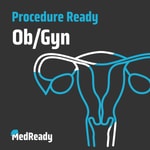Procedure Ready: Ob/Gyn – Details, episodes & analysis
Podcast details
Technical and general information from the podcast's RSS feed.

Procedure Ready: Ob/Gyn
Jennifer Doorey, MD, MS
Frequency: 1 episode/103d. Total Eps: 21

Recent rankings
Latest chart positions across Apple Podcasts and Spotify rankings.
Apple Podcasts
🇺🇸 USA - medicine
31/07/2025#96🇺🇸 USA - medicine
30/07/2025#88🇺🇸 USA - medicine
29/07/2025#82🇨🇦 Canada - medicine
28/07/2025#66🇨🇦 Canada - medicine
26/07/2025#83🇺🇸 USA - medicine
26/07/2025#92🇨🇦 Canada - medicine
25/07/2025#48🇨🇦 Canada - medicine
24/07/2025#54🇨🇦 Canada - medicine
23/07/2025#63🇨🇦 Canada - medicine
21/07/2025#80
Spotify
No recent rankings available
Shared links between episodes and podcasts
Links found in episode descriptions and other podcasts that share them.
See all- https://www.bedsider.org/methods
4 shares
RSS feed quality and score
Technical evaluation of the podcast's RSS feed quality and structure.
See allScore global : 79%
Publication history
Monthly episode publishing history over the past years.
Operative Vaginal Deliveries
Season 1 · Episode 21
vendredi 9 juin 2023 • Duration 13:36
Incidence:
3.3% as of 2013
Indications:
- Prolonged second stage
- Risk of fetal compromise
- Shortening 2nd stage for maternal benefit (ex: cardiac conditions)
Consent:
- Comparison is c-section typically
- Failure rate of OVD is ~3-6%
- Forceps has higher success rate over vacuum, but also higher risk 3rd/4th degree tear
- Risks to both mom and baby
Prep:
- Fetus appropriate station/position
- Anesthesia
- Empty bladder
- Assess Pelvis/Passenger sizes/fit
- OR Ready
- Peds available
Episiotomy – NO!
Contraindications
- Fetal conditions, known or supspected: bone disorders (OI), bleeding disorders
- Maternal infections: Hep C, HIV, etc
- Concern for shoulder dystocia/cephalo-pelvic dysproportion
Induction of Labor
Season 1 · Episode 20
vendredi 9 juin 2023 • Duration 17:53
Indications:
- Post-dates (42+wks)
- Late Term (41+ wks)
- Elective 39+wks
- Diabetes
- Hypertension
- Many more - check out ACOG Medically indicated delivery
39week induction
ARRIVE Trial - Multicenter RCT showing benefit to 39wk IOL over expectant management to ~41wks
Included
- Primips
- No medical indications for IOL prior to 40+5
Results
- IOL group had LOWER c-section rate than expectant group
- Neonatal composite outcome had a trend (not statistically significant) toward lower neonatal compilations in IOL group
Conclusion
- IOL at 39wks is as safe as expectant management without increased risks
- Many pregnant people are now offered a 39wk IOL rather than waiting for spontaneous labor
The IOL Process:
Evaluate and Prep:
- Full H&P
- Ultrasound for position - Vertex
- VE for cervical exam: dilation/effacement/Station, also position and consistency
- Calculate Bishops Score → help determine mode of IOL
Options for IOL: if biship score <8 for prime or <6 for multip, ripen first!
- Mechanical cervical ripening (balloon)
- Chemical cervical ripening (misoprostol or cervidil)
- Best yet--both!
Contractions (pitocin)
- Prime: Pitocin alone if Biship 8 or higher
- Mulitp: Pitocin alone if bishop 6 or higher&n
Postpartum Hemorrhage
Season 1 · Episode 9
mercredi 13 décembre 2017 • Duration 24:44
Causes (Four T’s):
- Tone: Atony
- Pitocin
- Misoprostol: CI-allergy, SI-transient hyperthermia
- Methergine: CI-HTN, SE-HTN
- Hemabate: CI-asthma. SE-diarrhea
- Tamponade: bakri/utah balloons
- Trauma: Lacerations
- Tissue: Retained POC (placenta or membranes)
- Thrombin: Coagulopathy
- Other: Involution
Preterm Labor and PPROM
Season 1 · Episode 7
mercredi 13 décembre 2017 • Duration 20:55
ACOG Practice bulletin: # 171
PTL or TPTL: Preterm <37wks, cervical change
Evaluation:
SSE first: Collect GC/CT cultures, FFN (no gel, blood or semen), GBS, eval for rupture if needed
SVE:
Cervical change–can dilation or effacement changes
FFN: Fetal fibronectin
If tPTL:
- Magnesium for neuroprotection if <32wks, decrease CP rates
- Betamethasone for fetal lung development
- PCN
- Tocolysis for steroid window (48hrs) if <34wks, questionable if 34-36+6. Indocin if <32 wks, Nifidipine if 32+wks
- IV fluids
- NICU consult
PPROM: Preterm <37wks, Ruptured membranes
SSE: Confirm rupture with Pooling, nitrazine ferning. Collect GC/CT and GBS.
If PPROM: Delivery at 34wks or at diagnosis if chorio or 34+wks
- Latency antibiotics: Erythromycin/Azithromycin, Ampicillin x 2 days, PO Erythro/Amoxicillin x 5 days
- Magnesium for neuroprotection if <32wks, decrease CP rates
- Betamethasone for fetal lung development
- PCN
- NO Tocolysis
- NICU consult
Indications for a c-section during labor
Season 1 · Episode 6
dimanche 3 décembre 2017 • Duration 15:59
- Nonreassuring fetal heart tracing
Category 2-remote from delivery
Minimal/absent variability is most significant predictor of fetal acidemia
Category 3 any time is emergent deliver - Failed IOL
Many different definitions: Most commonly 12-24hrs ruptured membranes on pitocin without active labor - Arrest of dilation
Can only meet criteria once in active labor 6cm or greater
Do you know if her contractions are adequate? IUPC with MVUs>200-250
If the contractions are adequate, no change over 4hrs
If contractions are inadequate or no IUPC, no change over 6hrs - Arrest of descent
Prime with epidural 3hrs
Prime without epidural-2hrs
Mutlip with epidural 2hrs
Multip without epidural 1hr - Cord prolapse
-Emergency! - Malpresentation
-Breech, transverse, compound
Birth Control
Season 1 · Episode 15
dimanche 3 décembre 2017 • Duration 20:16
Before Your First: Hysterectomy
Season 1 · Episode 12
lundi 20 novembre 2017 • Duration 20:39
What approach: Abdominal, laparoscopic, vaginal or combination
Taking or leaving the tubes and ovaries?
Tubes: What benefit do they provide? Risk?
Ovaries: What benefit do ovaries provide? What about after menopause? Still have benefit for bones and cardiovascular health. 65yr old cut-off
If it’s laparoscopic–listen to the LSC podcast for more details on the approach
Let’s talk about important steps:
- The round ligament: What artery runs inside the round? Sampson’s.
- What structure conceals the blood flow to the ovary? The IP ligament (formerly the suspensory ligament of the ovary). The artery comes from the aorta, so if this is transected before it is fully sealed, it can hemorrhage while retracting back into the retroperitoneum. Badness!
- What are the four levels at which the ureter is injured during hysterectomy? 1- At the pelvic brim, 2- medial to the IP ligament, 3- as it passes under the uterine artery (water under the bridge) and 4- lateral to the vaginal cuff closure.
- Ligate and transect the uterine arteries–the uterus should blanch white.
- Colpotomy– disconnecting uterus from vagina
- Close vaginal cuff if total hyst
Before Your First: Laparoscopy
Season 1 · Episode 11
dimanche 19 novembre 2017 • Duration 29:04
Review anatomy– you’ll be able to see well!
Pimped- Youtube Channel videos for laparoscopic anatomy
What case are you doing and why?
Review common indications, steps to procedure and potential risks/complications
Saying hi to the patient first
Being helpful setting up — yellowfins or stirrups for lithotomy
Scrubbing in — ask to grab your gown/gloves for the scrub, open carefully or get help if unsure
Abx: If entering uterus or vagina ie hyst
Prep: infection prevention with chloraprep or something
EtOH based, needs to evaporate before draping or risk fire!
Vaginal prep — betadine or chlorhexidine
Then everyone scrubs
Let resident/attending drape unless asked.
You may be asked to help with foley/manipulator
Uterine manipulators: Many sizes/shapes/types
Vagina is dirty– can’t go from vagina to abdomen
Abdomen:
Entry: Typically in umbilicus or just above. Can use Palmer’s Point if needed.
Direct visualization with Hassan
Visiport
Veres needle
Insufflate with CO2
Port placement: Typically middle ⅓ of distance between ASIS and umbilicus. Avoid obvious superficial vessels and inferior epigastric –watch from below
Common procedures:
- Dx LSC– endometriosis, adhesions
- Tubal ligation or bilateral salpingectomy
- Cystectomy
- BSO
- Hysterectomy
Closing ports: Close fascia on ports >5mm due to increased risk of hernia
Post-op checks: Many LSC cases are same-day, meaning patients go home
-Nausea/vomiting, eating/drinking, voiding, passing flatus, ambulating
-UOP, BPs,
Hypertension in Pregnancy
Season 1 · Episode 5
dimanche 19 novembre 2017 • Duration 24:06
Hypertension in Pregnancy — One large spectrum
Mild range: 140/90
Severe range 160/110
CHTN → SIPE
gHTN → Pre-E
BP meds: Methyldopa, labetalol, hydralazine, nifedipine
Severe features:
- BPs
- Neurologic symptoms
- Lab findings:
HELLP
Hemolysis, Elevated Liver (enzymes), Low Platelets
Eclampsia — Seizures
Before Your First: Cesarean Section
Season 1 · Episode 4
mardi 14 novembre 2017 • Duration 25:41
Why?
Scheduled: Repeat cesarean, hx of uterine surgery, abnormal placentation (placenta previa, vasa previa, accrete, etc) malpresentation (not cephalic), multiple gestation
In labor: arrest of dilation, arrest of descent, nonreassuring fetal heart tones, elective
Anatomy: Layers of anterior abdominal wall: skin, subcutaneous tissue, superficial fascia (Campers, scarpa’s), external oblique muscle, internal oblique muscle, transversus abdominis muscle, transversalis fascia, preperitoneal adipose and areolar tissue, and peritoneum. Nerves, blood vessels, and lymphatics are present throughout.
Now you’re at the uterus — or should be. Clear the surgical field, take down adhesions, bladder flap if needed.
Hysterotomy — lower uterine segment, lateral uterine vessels to avoid
Delivery baby — delay cord clamp, placenta
Likely lots of bleeding — same atony meds as vaginal delivery
Clean inside of uterus to remove all membranes etc.
Possibly exteriorize uterus to see better — depends on scaring
How can you be helpful — visualization! Bladder blade back in, suction or clean with lap between when surgeon placing sutures.
Two layers to hysterotomy if they might ever want to labor again or if needed for hemostasis.
Clean up the abdomen–irrigation vs moist laps vs suction
Now to close:
Peritoneium — either way, close or not– no evidence either way
Muscle– don’t close, evidence that closing it can cause hematoma
Fascia–Close!
Closing Fascia:
Nerves at the lateral edges of the fascial incision are ilioingiunal, iliohypogastric
Subcutaneous fat — if >2cm depth, close to reduce risk of seroma/hematoma/infection
Skin closure — stables, suture, absorbable stables


